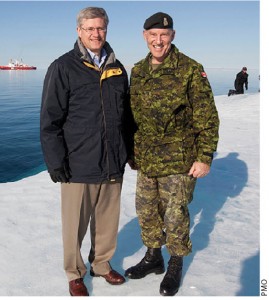
There’s a kind of scorecard for where Canada stands in Arctic development compared to its Arctic neighbours, particularly Norway.
In 2006, Norway published a detailed, 92-page outline of what it intended in its Arctic territory, and updated it three years later. Canada got around to the same kind of outline in 2009, and it had full text in English, French and Inuktitut crammed into its mere 40 pages.
With about 39 million square kilometres of polar sea ice during the darkness of winter and about 21 million in summer, the Arctic is a huge, relatively self-contained ecosystem with vast economic and strategic potential. And climate change is making it an accessible option for development and resources.
It’s been overlooked until now by much of the world as of no use to anyone beyond its few inhabitants. But as the big melt continues, governments, scientists and industries are beginning look to the top of the globe.
Canada has lagged behind other more organized and engaged regional neighbours in the Arctic, including Russia with its history of Arctic exploration and its fleet of seven nuclear icebreakers and plans for more. And the United States tabled a policy update with a strong national security emphasis in January 2009. The U.S. plan begins with the statement, “The United States is an Arctic nation, with varied and compelling interests in that region,” and goes on to outline what those interests are and how they intend to pursue them.
But in a less menacing way, Norway, using resources based primarily on money from oil, has been actively engaged in Arctic economic development and its clear-headed action is something Canada would do well to emulate.
In 2006, the Storting, Norway’s parliament, established its high-north policy. In an update in early 2009, it said the North was “Norway’s most important strategic priority area.” It’s there for anyone to read in New Building Blocks in the North: the Next Step in the Government’s High North Strategy.
While Canada has a vague plan set out in Canada’s Northern Strategy, a document produced last year, it lacks detailed legislation to address the Arctic.
With clear policy guiding its government, Norway has energetically pursued research, funding and development in its northern regions, particularly in climate research, the environment and biodiversity. It has also invested in better satellite technology for shipping and scientific research in the north.
The country set seven political priorities for the region (including the intent to be the best steward of the environment and natural resources in the north), and put together a timeline with a 15-year horizon.
Norway’s first goal is to “develop knowledge about climate and the environment in the high north,” the Building Blocks document says. It has pumped in more than $250 million (the Canadian dollar equivalent of 1.5 billion Norwegian krone) since 2006, when it allocated NOK 350 million ($58.7 million) through the Research Council of Norway. (Norway’s population is about 15 per cent of Canada’s.)
Along the way, the Norwegian plan lays out details of improved responses to oil spills. Norway’s interest in developing the oil industry in the North is based on lots of experience and expertise in offshore drilling.
Statoil, Norway’s state-owned oil and gas company, is the largest offshore oil and gas company in the world and much of its product comes from the country’s continental shelf and northern gas fields. It calls itself “a test lab for technology development.”
In that vein, Norway is currently developing a centre for climate and environmental research in Tromsø, a northern city which is also home to the Norwegian Polar Institute and the University of Tromsø, a leader in high north research.
In contrast, Canada, with immense Arctic territory and one of the few nations with indigenous people living there, has struggled to create a lasting Arctic policy. Canada’s Northern Strategy says the government “recognizes what must be done to secure the future of Canada’s North, for the benefit of all Canadians, and is taking concrete action to turn this vision for the North into reality.”
But it provides few details, simply a list of intentions including the preservation of Arctic sovereignty. It cites long-established mining and gas projects like the Mackenzie gas pipeline as cornerstones of “sustained economic activity in the North,” but lays out no plans for future development.
Scientists anticipate an all-season Northwest Passage and other sea routes soon. But at the University of Alberta, Arctic expert John England says the lack of a clear Arctic policy means Canada cannot hope to compete, prosper or lead in a region where so many nations have a stake.
“I think we do a lot of posturing and it’s time we stop posturing and actually get down to the brass tacks and produce a proper national policy on the Arctic,” he said.
The Canadian Arctic conversation centres on sovereignty disputes with Denmark and the United States as well as concerns over Russia, while Norway is forging ahead, an untapped source of experience and progress in the region.
For the government, Foreign Minister Lawrence Cannon released a statement on Arctic policy in August. “The Arctic is part of us. Was, is and always will be,” he said. “The importance of the Arctic and Canada’s interest in the North has never been greater,” he added.
But Dr. England says a strategy alone fails to commit government departments to action and Canada cannot expect to compete with Russia and the U.S. without a clear policy, particularly when it comes to research. While Canada was the largest contributor to International Polar Year research projects between 2007 and 2009, scientists, including Dr. England, are sceptical about the country’s ability to maintain those projects without policy commitments.
Over this past summer, the Canadian military and the Department of Foreign Affairs staged Operation Nanook, a yearly Arctic exercise to reinforce Canada’s sovereignty in the North and to let the military practise responses to mock disasters. This year, Operation Nanook, which ran August 6-26, involved sovereignty patrols, emergency preparedness training and military exercises. American and Danish troops were invited to participate for the first time with a total of 1,500 troops from the three countries in action.
“For far too long, we feel that the Arctic hasn’t been spoken for and we believe it’s time that Canada takes full recognition of the importance of the Arctic,” Minister Cannon said in his statement to the media in August. He then expanded on the country’s Northern strategy, adding an international element to the plan.
He said Canada would work with regional neighbours in developing the North and continue to promote Canadian arctic sovereignty abroad, he said. “We will pursue targeted actions on the international level to advance our sovereignty agenda in concrete ways,” including the settlement of boundary issues with the U.S. and Denmark.
While Canada is focused on military exercises to promote its sovereignty, Norwegian Foreign Minister Jonas Gahr Støre’s government proposed a record increase in funding for the Arctic of almost $90 million for 2010. Canada has no exact figures readily available for total investment in the North, though the 2010 budget includes more than $400 million for scientific research in the North over the next two to five years.
Rune Raelfson, the head of the Norwegian Barents Secretariat, a regional alliance of Russia, Norway, Finland and Sweden, says he sees great opportunities for the Arctic, but is critical of a solely research-based focus at the expense of development.
“If you look at the Arctic Council, it has been a research-driven institute. They are more interested in ice and polar bears than they are in the economic development of this area.” Raelfson says economic development is necessary for the well-being of people living in the North, and it would include oil exploration.
On the other side of the Arctic Ocean, Minister Cannon seems to agree stating, “Creating a dynamic and sustainable northern economy is essential to improving the well-being of northerners and unleashing the true potential of Canada’s North.”
This land of the midnight sun matters to Norway in a way that is only beginning to take root in Canada. The challenge is to catch up.
Chantaie Allick is an Ottawa-based freelance journalist and master’s student at Carleton University.






